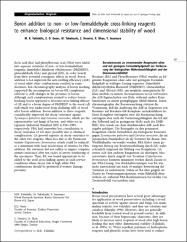Boron addition to non- or low-formaldehyde cross-linking reagents to enhance biological resistance and dimensional stability of wood
Özet
Boric acid (BA) and phenylboronic acid (PBA) were added into aqueous solutions of non- or low-formaldehyde reagents; dimethylol dihidroxy ethyleneurea (DMDHEU), glutaraldehyde (GA) and glyoxal (GX), in order benefit from their potential synergistic effects in wood. Boron addition to GA improved the anti-swelling efficiency (ASE) of wood while other combinations resulted in some decreases. Ion chromatography analysis of boron leaching supported the presumption on boron-GX complexion referred to ASE changes in the presence of boron. Although such complexations seemed to reduce boron leaching, boron appeared to decrease cross-linking efficacy of GX and to a lesser degree of DMDHEU to the wood cell wall which was understood from declining ASE of wood after boron addition. Boron addition to these reagents considerably improved the decay resistance against Tyromyces palustris and Coriolus versicolor, which are the representative test fungi of brown- and white-rot in Japanese Industrial Standard (TIS) A-9201-1991, respectively. PEA had somewhat less contribution to decay resistance of GX most possibly due to chemical complexation. GA proved superior in decay resistance to the other two reagents. Mass loss due to the Formosan termite Coptotermes formosanus attack could be reduced to a minimum with total inactivation of termites by PEA addition. BA retention did not suffice to impart complete termite resistance after ten cycles of severe weathering of the specimens. Thus, BA was found appropriate to be added to the used cross-linking agents in such service conditions where decay risk is high while PEA combinations should be preferred if termite damage prevailes.


















